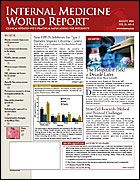Publication
Article
Internal Medicine World Report
Esomeprazole Reduces Ulcer Formation in Patients Taking Prophylactic Aspirin
Author(s):
LOS ANGELES—It has long been established that low-dose aspirin reduces the risk of recurrent events in patients with cardiovascular disease (CVD) or cerebrovascular disease, but that benefit carries a risk of 11% for gastroduodenal ulcer formation. Use of a proton-pump inhibitor (PPI) has been suggested as a possible approach to prevent ulcer formation. Results of a new study presented at Digestive Disease Week indicate that taking the PPI esomeprazole (Nexium) for 6 months along with low-dose aspirin can safely reduce that risk.
Angel Lanas, MD, Gastroenterology Service, Clinical University Hospital, Zaragoza, Spain, investigated the incidence of duodenal ulcers in older patients requiring prophylactic aspirin for CVD or cerebrovascular disease. Patients were recruited from 80 centers in 11 countries.
Helicobacter pylori
To be included in the study, patients had to be ≥60 years and have a condition requiring low-dose aspirin, such as CVD and/or cerebrovascular disease. They also had to be free of current gastrointestinal (GI) symptoms requiring treatment, free of current/active ulcer and reflux esophagitis greater than Los Angeles grade A (mucosal break ≤5 mm in length), and –negative.
At baseline, patients were taking a mean daily aspirin dose of approximately 124 mg. Endoscopy was performed at baseline and at 2 and 6 months.
This double-blind, randomized, parallel-group study included 991 patients aged ≥60 years (mean age, 69 years; 57% men) who were randomized to enteric-coated, low-dose (75-325 mg/d) aspirin plus esomeprazole 20 mg/day, or placebo for 6 months.
P
Two months after study onset, ulcers had developed in 0.2% of esomeprazole-receiving patients and 2.2% of those taking a placebo. At 6 months, significantly more patients in the esomeprazole group were ulcer free than in the placebo group (98.2% vs 93.8%, respectively; = .007). Among those who did develop ulcers (9 with esomeprazole; 31 with placebo), the size of the ulcer was generally smaller in the esomeprazole group.
P
P
P
Patients assigned to 6-month esomeprazole therapy were also significantly less likely to develop esophageal lesions (81.7% vs 95.6% with placebo; <.001). Dr Lanas noted that “close to 20% of patients taking aspirin had esophagitis,” but those taking esomeprazole were significantly less likely to report epigastric burning or discomfort ( = .008) or heartburn ( = .026).
The 20-mg esomeprazole dose was well tolerated in this older population. Among ulcer-free patients, more discontinuations occurred in the placebo group (18.9%) than in the esomeprazole group (13.6%).
Analysis showed that the most significant predictor of GI complications was older age. “Being 70 years old is a significant risk factor for GI complications,” Dr Lanas said. “Among at-risk patients receiving low-dose aspirin, concomitant treatment with esomeprazole is more effective than placebo in prevention of gastroduodenal ulcers and esophageal lesions and lessens the occurrence of GI symptoms.”
KEY POINTS
About 11% of patients taking low-dose prophylactic aspirin develop ulcers.
Evidence shows that 6 months of esomeprazole therapy significantly lowers the risk for ulcers.
Esomeprazole therapy also reduces GI symptoms, such as epigastric burning and heartburn.
The 20-mg dose appears safe and well tolerated in this elderly population, which is at increased risk for GI complications.





